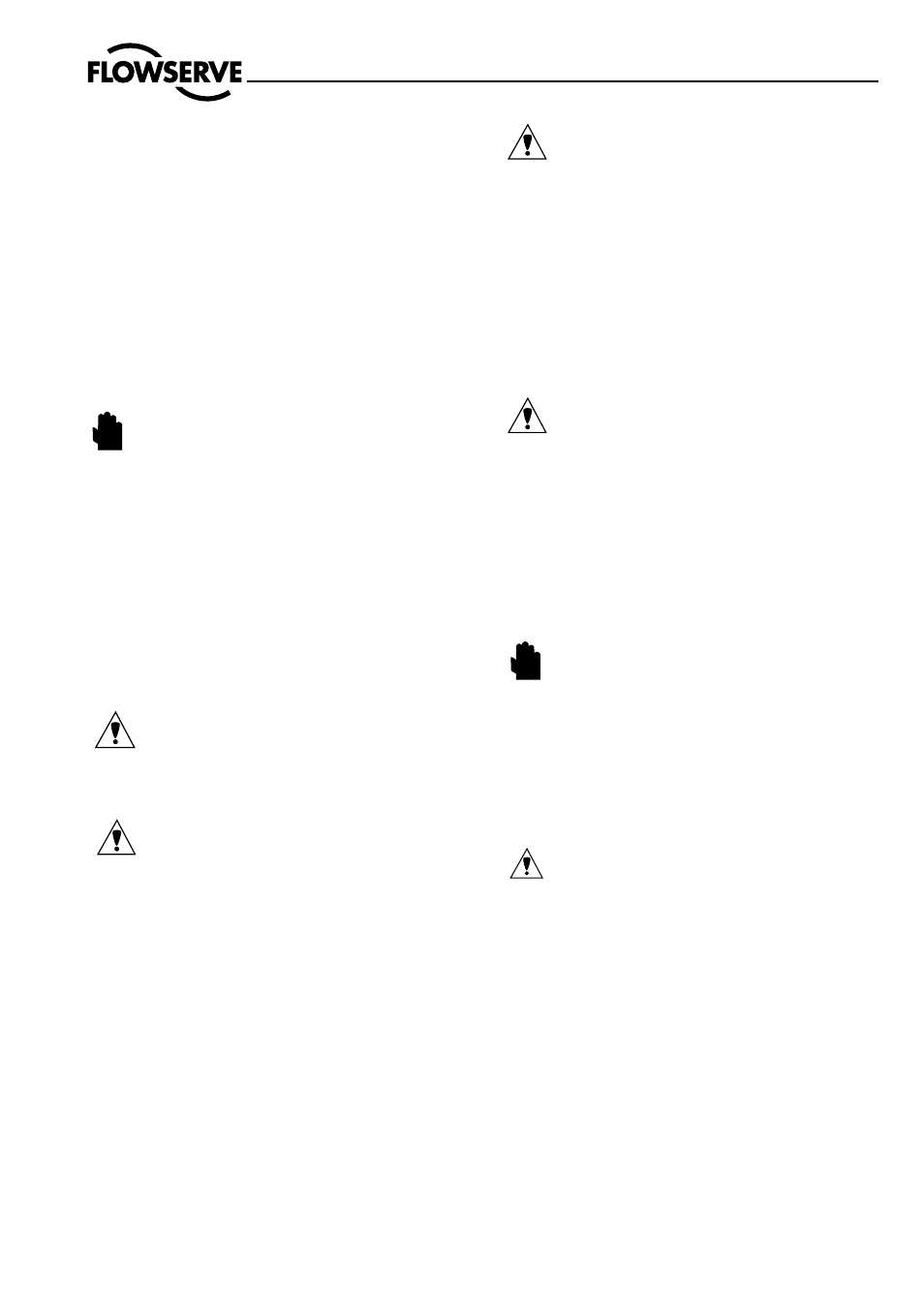Flowserve 020000 Series Kämmer Split Body Valves User Manual
Page 5

5
Flow Control Division
Kammer Control Valves
6
REMOVE AND INSTALL ACTUATOR
General Information
We recommend separating the actuator from
the valve during all repair work. However, many
maintenance and adjusting operations can be carried
out in an installed condition.
6.1
Remove series 4 actuator
(see Fig 1 + 2)
For series 2 actuator see 6.3
For actuators with spring-to-close, go to 6.1.1
For actuators with spring-to-open, go to 6.1.2
6.1.1 Shut off air supply.
WARNING: Depressurise the line to atmospheric
pressure and drain all fluids from the valve before
working on the actuator. Failure to do so can cause
serious injury.
6.1.2 Remove cap and nameplate. Tighten zero adjusting
nut until it just touches the surface of the spring
housing. This relieves the plug from actuator spring
pressure. If the actuator is fitted with a handwheel
this can be used to relieve the plug from actuator
spring pressure.
3.1.3 Using a wrench, secure the actuator stem against
turning and using a second wrench loosen the stem
locknuts. If the actuator is fitted with a coupling
refer to the procedure described in the maintenance
instructions for the I/P actuator.
CAUTION: The actuator stem must not be rotated,
as this will cause damage to the diaphragm.
6.1.4 Loosen gland and clamp nuts.
6.1.5 Secure plug stem against turning and unscrew actua-
tor from plug stem by rotating counter-clockwise.
CAUTION: Ensure that the plug assembly is not
rotated with the plug seated. This may cause ir-
reparable damage to the seating faces.
6.1.5 Remove actuator and remove at the same time
locknut, travel indicator disc, gland nut and clamp
nut.
3.2
Install series 3 actuator
Information:
•
Before the actuator is installed, it must be
calibrated according to section 3 of the instructions
„Pneumatic and Electro-pneumatic Actuators“.
•
All worn or damaged parts must be re-
placed. Reusable parts must be clean.
6.2.1 Position actuator with clamp nut, gland nut, locknuts
and travel indicator disc on the valve.
6.2.2 Only for „spring-to-close“ actuators:
Screw actuator onto plug stem by rotating clockwise,
until the yoke plate just touches the valve housing
and the actuator is aligned forward. If the actuator
is fitted with a coupling refer to the procedure de-
scribed in the maintenance instructions for the I/P
actuator.
CAUTION: Ensure that the plug assembly is not rotated
with the plug seated. This may cause irreparable dam-
age to the seating faces.
Only for „spring-to-open“ actuators:
Lift plug stem and screw it into the lower coupling half
until the distance between „plug in seat“ and „plug
raised“ approximately corresponds to the specified
stroke.
6.2.3 Tighten clamp nut and gland nut.
6.2.4 Adjust seat tightness by screwing/unscrewing the plug
stem in/out of the actuator stem.
CAUTION: Ensure that the plug assembly is not rotated
with the plug seated. This may cause irreparable dam-
age to the seating faces. Open valve, make adjustment,
close valve and check for leaks. If the valve is fitted
with a bellows seal the plug stem may NOT be rotated
at all. In the case of a bellows seal adjustments are
made with the coupling.
6.2.5 After adjusting, secure the locknuts and the travel
indicator disc lying between them against actuator
stem and align the travel indicator on the yoke rod.
6.3
Remove series 2 actuator
(see Fig. 1a)
For series 4 actuator see 6.1
6.3.1 Shut off air supply.
WARNING: Depressurise the line to atmospheric
pressure and drain all fluids from the valve before
working on the actuator. Failure to do so can cause
serious injury.
6.3.2 Disconnect all tubing.
6.3.3 Remove 2 screws and remove coupling.
6.3.4 Remove yoke rod retaining nuts and lift actuator
assembly from the valve.
6.3.5 Remove coupling insert and it’s locknut from plug
stem.
CAUTION: Ensure that the plug assembly is not
rotated with the plug seated. This may cause
irreparable damage to the seating faces.
6.4
Install series 2 actuator
(see Fig. 1a)
The actuator stem must be fully extended:
Actuators with air-to-open action must be fully
vented. Actuators with air-to-close action apply
supply pressure.
Manually depress the plug stem to ensure the plug is
fully seated.
6.4.1 Screw coupling insert locknut and coupling insert as
far as possible onto plug stem.
6.4.2 Place the actuator assembly on the valve engaging the
yoke rod threads in the lower yoke plate and ensuring
the actuator faces in the correct direction.
STOP!
STOP!
